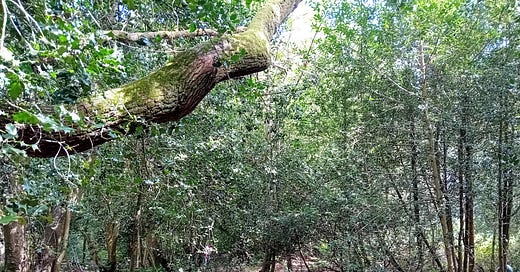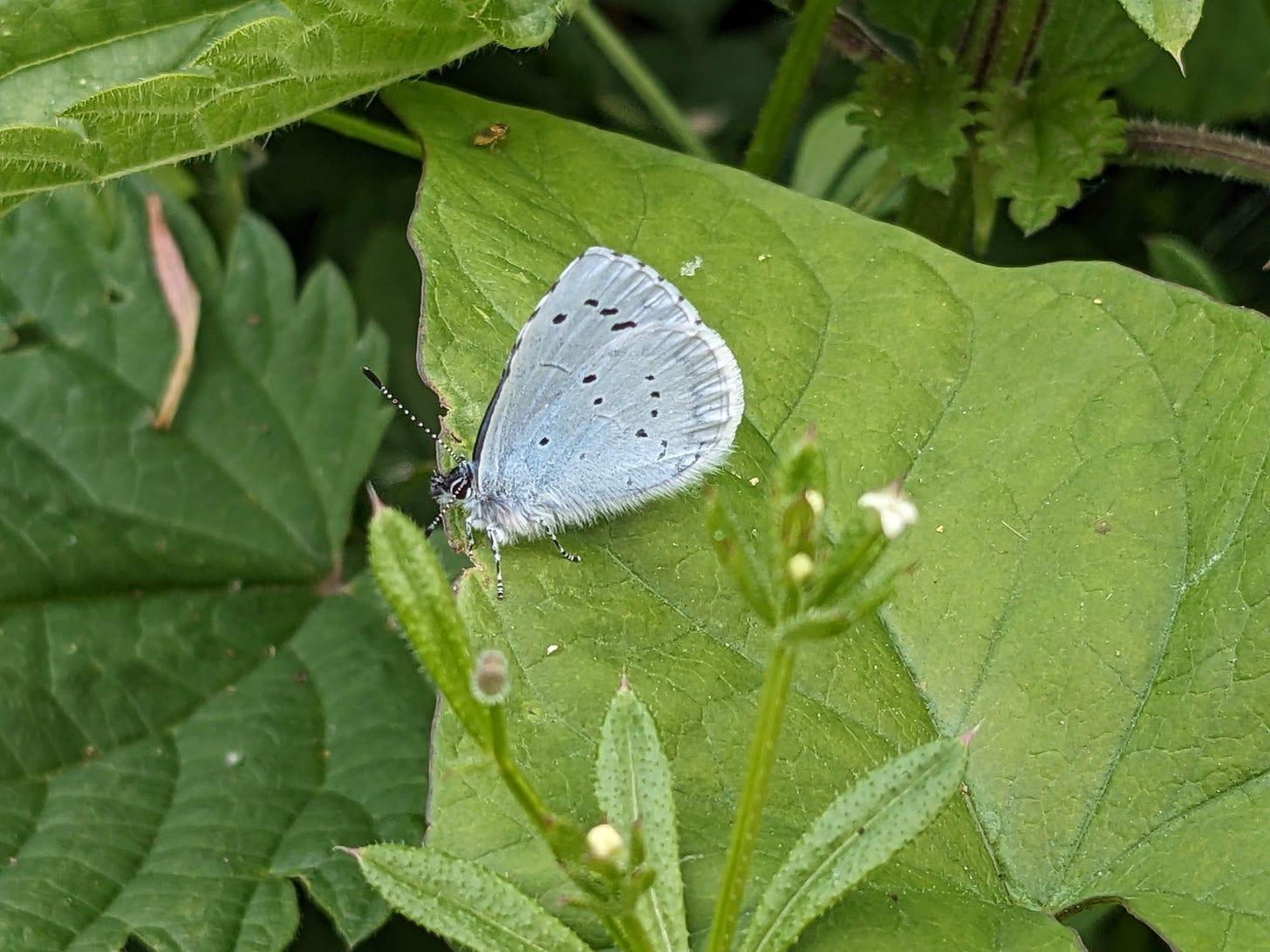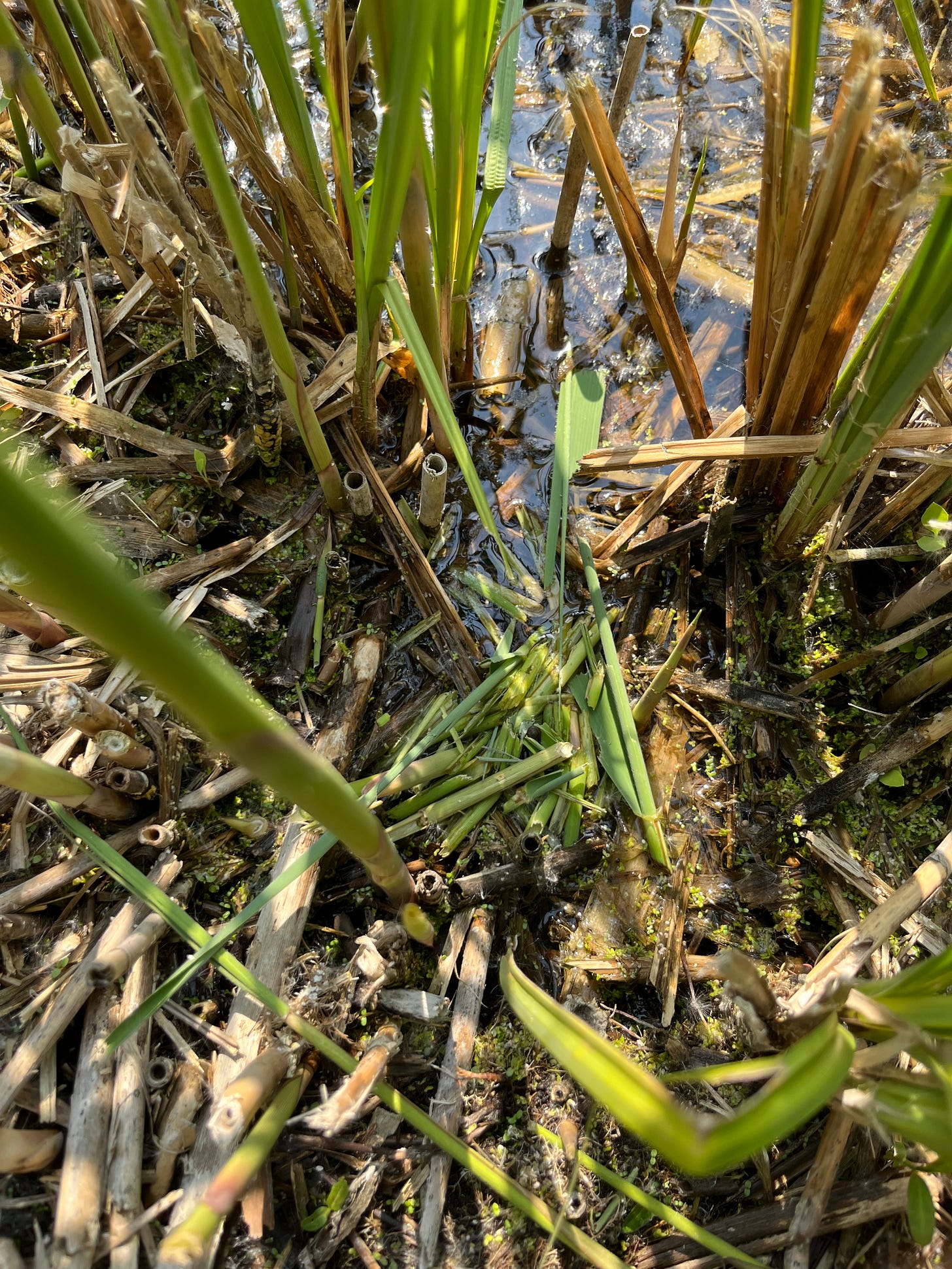The Holly and the Wood Sorrel
How a warming world is creating winners and losers in our woods plus a brief update on water voles
It is May Day, but the blazing heat makes it feel more like high Summer than late Spring. There’s little shade on the suburban street I’m walking along, and the sun bounces off all the paved surfaces, making it feel even hotter. Many of the front gardens have been paved over for parking and in most only tiny strips of greenery remain. In front of one house a magnificent magnolia is marooned in a sea of what looks like newly laid brick paving. I’m glad the tree survived the garden clearance, but I worry for its future chances. How will it cope with vehicles parking over its roots, and the difficulties of getting enough moisture from the paved earth?
I would normally walk quickly along a street like this, but the heat today soon forces me to slow my pace. I’m on my way to Threehalfpenny Wood to join TCV (The Conservation Volunteers) Croydon and the last part of my journey takes me through neighbouring Spring Wood. It is still warm under the trees but noticeably cooler than on the surrounding streets. Here the birds are singing exuberantly, there are bright green new leaves on the oak trees and small pockets of greater stitchwort add splashes of white to the bluebell carpets. Maybe if you have all this at the end of your road, you don’t feel the need to see anything green from your front window, but I wonder how many of the residents of the street I’ve just walked along find their way into these woods.
Today’s TCV task is removing some of the holly which is starting to dominate the understorey in parts of Threehalfpenny Wood. Holly is a native plant and has lots of wildlife benefits. Birds eat its berries and it’s also the food plant for the caterpillars of one of my favourite butterflies – the Holly Blue - or at least for its first brood of the year. Confusingly, the caterpillars of the second brood of Holly Blues which appear later in the year feed on ivy. However, as holly is evergreen and casts shade all year round, an overabundance can make it hard for other plants to establish which is why we need to reduce its presence here.
Woods are one of the best places to escape the heat on a day like this, but they too are being affected as the changing climate favours certain species over others and last year, the UK Centre for Ecology and Hydrology (UKCEH) published research which demonstrates just how much impact that is having. The research is based on detailed surveys of around 100 broadleaved woodlands across Britain which were originally undertaken in 1971 and then repeated in 2001 and 2021 and so provides striking evidence on how the woods have changed over the last 50 years.
One of the key findings is that “the rise in minimum winter temperatures has led to an increase in holly by 16%, meaning it is now more common than hawthorn and beech in broadleaf woods”. The report also highlights other factors such as lack of management, disease and increasing deer numbers which are having an impact, for example, the lack of management has led to woods becoming shadier with fewer but older and larger trees.
These changes have implications for the flora on the woodland floor too leading to increases in shade-tolerant species, such as bluebells, and reductions in a number of other species. The plant species we’re losing are ones like wood sorrel, thyme and birds-foot trefoil which support pollinators, making their loss even more worrying given the widespread declines in pollinating insects in Britain in recent decades. The most shocking finding from the UKCEH research is that overall species diversity in the surveyed woods had decreased by 22% between 1971 and 2021. Learning that we’ve lost nearly a quarter of our woodland species in my lifetime, I remember the time an ecologist told me that he didn’t like seeing the vast swathes of bluebells that are so often celebrated as there should really be a much greater variety of other plants mixed in with them.
While researching holly after returning from Threehalfpenny Wood, I discover from Richard Mabey’s Flora Britannica that the plant was regularly used as cattle fodder in the past. The tops of the trees would be lopped and fed to stock during the winter as “its leaves have one of the highest calorific contents of any tree browsed by animals and are rich in nutrients.” Mabey records many of the superstitions associated with holly too. It was once commonly believed that cutting down whole holly trees would bring bad luck, perhaps something that dates from a time when the tree had many uses so it would have been important to care for it in a way which ensured it continued to grow. There was also a belief that holly had power over horses and its pliable wood meant that it was popular for use in driving whips which would have been in high demand in the 19th century when all transport was horse-drawn. It was widely used as a boundary tree too.
Now it is not used for anything much besides Christmas decorations and, as our planet grows ever warmer, its presence in our woods is something of a mixed blessing – a tree which we would never want to be without but one that we don’t want in such numbers that its presence reduces the life chances of other species. By the time we’ve finished at Threehalfpenny Wood, the area we’ve been working in is more open and less shaded. Reducing the holly and allowing more sunlight to reach the woodland floor should give other plant species more of a chance to thrive now. But, as is so often the case with our conservation volunteering, it will be some time before we’re able to tell how much impact it has really had.
Water vole update for those of you that read my last post (and there’s a link below for those that missed it). When I went back to the River Cray with my friend, Clare, in late April, we didn’t find any signs of water voles. But Clare visited another section of the Cray the following week and found lots of evidence of their presence in the form of food stores and latrines. So they are definitely there. The photo below shows a pile of reeds with diagonally cut ends which is a sign they’ve been chewed by water voles.
To finish….
…a few things I’d like to share:
Urban Tree Festival: Running from 10 to 18 May this year, the Urban Tree Festival is an annual celebration of trees in built-up areas with lots of walks, talks and other events in London and many other towns and cities across the UK. I enjoyed hearing the story of London’s ‘most famous street tree’ on a guided walk yesterday and the same walk is running again next Saturday.
Brockley Max Story Trail: Brockley Max is a great community arts festival with loads of different literature, music and other events. This year it will feature a story telling trail for the first time with various local writers reading their work at different venues on Sunday 1 June. I’ll be talking part and will be reading some of my nature writing at the top of One Tree Hill between 4.20 and 4.40pm. The online listings should be available soon but in the meantime you can access the programme here.
London Nature Films Festival: Another nature-related event coming up in the next few weeks is this short film festival on 14 and 15 June which I found out about from one of the other participants on yesterday’s tree walk. There are not many details yet of the films to be shown but it sounds like it could be interesting.







